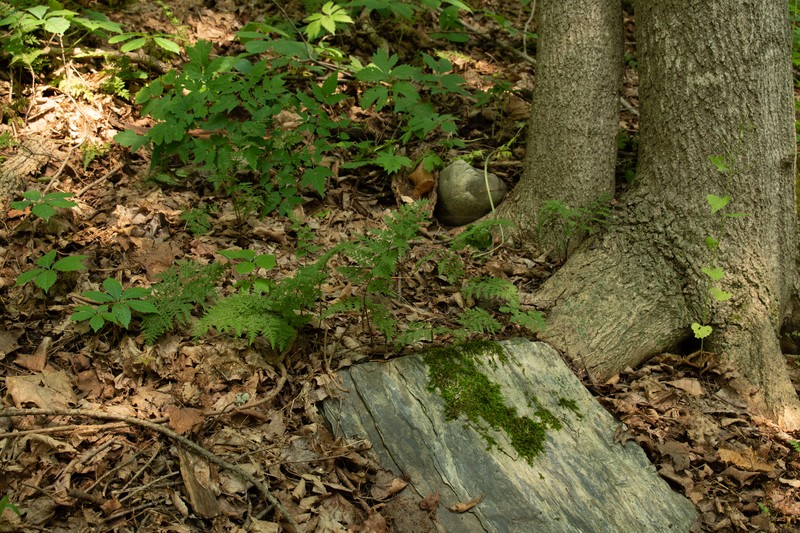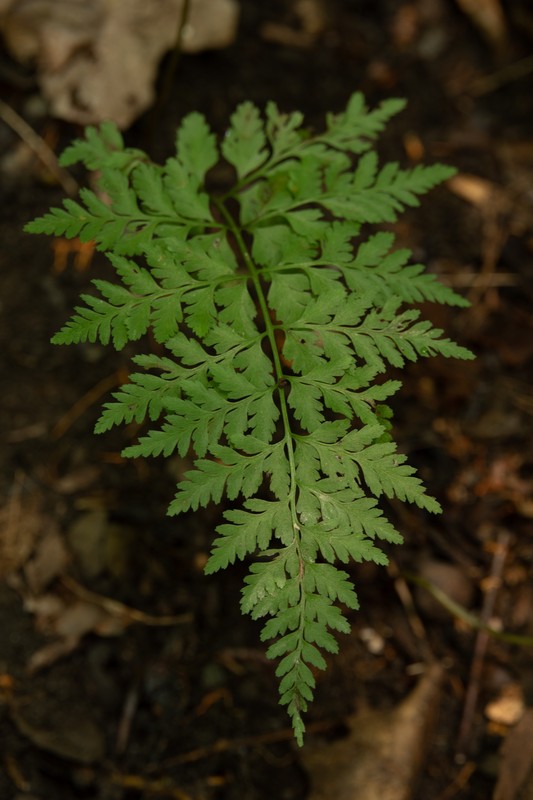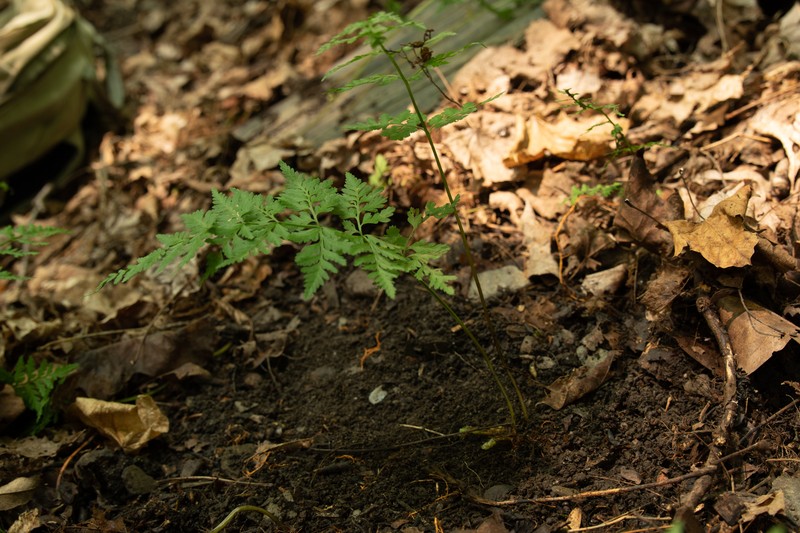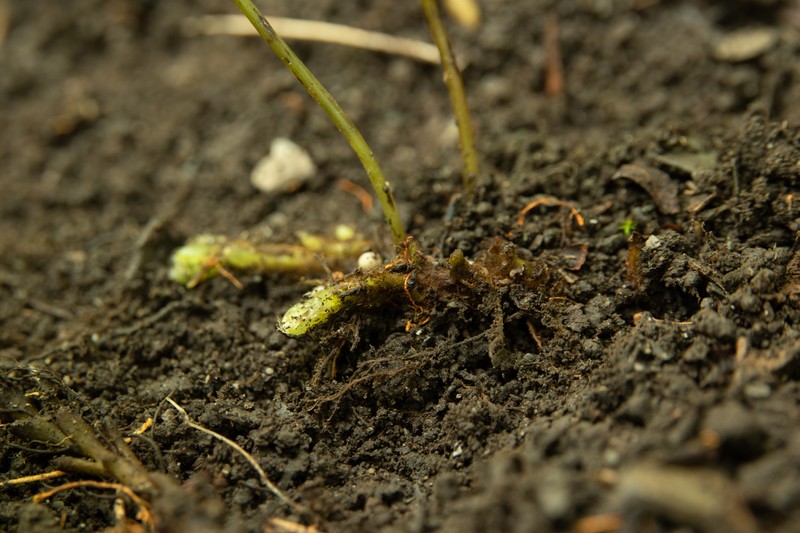Lowland Fragile Fern
Cystopteris protrusa (Weatherby) Blasdell
- Class
- Filicopsida (Ferns)
- Family
- Cystopteridaceae
- State Protection
- Endangered
Listed as Endangered by New York State: in imminent danger of extirpation in New York. For animals, taking, importation, transportation, or possession is prohibited, except under license or permit. For plants, removal or damage without the consent of the landowner is prohibited.
- Federal Protection
- Not Listed
- State Conservation Status Rank
- S1
Critically Imperiled in New York - Especially vulnerable to disappearing from New York due to extreme rarity or other factors; typically 5 or fewer populations or locations in New York, very few individuals, very restricted range, very few remaining acres (or miles of stream), and/or very steep declines.
- Global Conservation Status Rank
- G5
Secure globally - Common in the world; widespread and abundant (but may be rare in some parts of its range).
Summary
Did you know?
This is one of our plants that, while rare, was also once widespread across the state south of the Adirondacks. There is one occurrence known from eastern Long Island, one from Staten Island, one from Tompkins County, and two from near Lake Erie. The reason for this may be that, while it is common across southern Pennsylvania, it is mostly absent from the northern part of the state with a few populations extending the range of the species into New York.
State Ranking Justification
There is one existing population and it contains thousands of plants. There are three populations from the early 1900s which have not been resurveyed but habitat still exists. A population from 1899 is now extirpated because its habitat no longer exists.
Short-term Trends
The single population on Staten Island continues to do well.
Long-term Trends
Only five populations of this fern have ever been known from the state. Of the five only one is currently known to exist.
Conservation and Management
Threats
The known population may be threatened by future development in the natural areas that surround it. This may produce more visitation to the site and introduce unwanted disturbance to the plants.
Conservation Strategies and Management Practices
A natural buffer should be maintained around the population and a backup population should be maintained at a local botanical garden.
Habitat
Habitat
The only extant record in the state is from a sugar maple forest on a steep slope, growing on serpentine soil. (New York Natural Heritage Program 2010). In soil of moist, deciduous forest (FNA 1993). Mesic woods (Gleason & Cronquist 1991). Most rich (often calcareous) wooded slopes, rocky banks or alluvium (Fernald 1970).
Associated Ecological Communities
- Beech-maple mesic forest*
(guide)
A hardwood forest with sugar maple and American beech codominant. This is a broadly defined community type with several variants. These forests occur on moist, well-drained, usually acid soils. Common associates are yellow birch, white ash, hop hornbeam, and red maple.
- Hemlock-northern hardwood forest*
(guide)
A mixed forest that typically occurs on middle to lower slopes of ravines, on cool, mid-elevation slopes, and on moist, well-drained sites at the margins of swamps. Eastern hemlock is present and is often the most abundant tree in the forest.
- Maple-basswood rich mesic forest*
(guide)
A species rich hardwood forest that typically occurs on well-drained, moist soils of circumneutral pH. Rich herbs are predominant in the ground layer and are usually correlated with calcareous bedrock, although bedrock does not have to be exposed. The dominant trees are sugar maple, basswood, and white ash.
- Rich mesophytic forest*
(guide)
A hardwood or mixed forest that resembles the mixed mesophytic forests of the Allegheny Plateau south of New York but is less diverse. It occurs on rich, fine-textured, well-drained soils that are favorable for the dominance of a wide variety of tree species. A canopy with a relatively large number of codominant trees characterizes this forest. Canopy codominants include five or more of the following species: red oak, red maple, white ash, American beech, sugar maple, black cherry, cucumber tree, and black birch.
* probable association but not confirmed.
Associated Species
- Acer saccharum (sugar maple)
- Caulophyllum thalictroides (blue cohosh, late blue cohosh)
- Hydrophyllum
- Polygonatum
- Sanguinaria canadensis (bloodroot)
- Viola sororia (common blue violet)
Range
New York State Distribution
This fern is currently known from Staten Island with historical records from the North Fork of Long Island in Suffolk County, Tompkins County in the Finger Lakes area, and Erie County in western New York.
Global Distribution
This fern is most common from Pennsylvania across the northern Midwest to Iowa and south to Arkansas, Alabama, and western North Carolina and Virginia. It extends south to the panhandle of Florida and into a few areas of South Carolina while reaching its northern limits in New England, New York, and Ontario. The drier climate prevents its spread west from eastern Nebraska, Kansas, and Oklahoma.
Identification Comments
General Description
Cystopteris protrusa is a fern species with creeping, perennial, yellow-hairy stems. It grows rooted in the soil (as opposed to clinging to rocks or cliffs). Early season leaves are sterile, coarsely divided, and have rounded teeth. Later (late spring and early summer) leaves are larger (up to 45 cm long), finely divided, have sharp-pointed teeth,and are fertile. The pinnae (leaflets) are held roughly perpendicular to the petiole, have toothed margins, and are not hairy or glandular (FNA 1993).
Best Life Stage for Proper Identification
Lowland Fragile Fern can be identified any time the fronds are present.
Similar Species
Lowland fragile fern is our only Cystopteris species that grows on the forest floor rather than on rocks or cliffs, and whose stem has yellow hairs and protrudes past the current season's frond.
Best Time to See
Cystopteris protrusa produces spores from mid-May to early August.
- Vegetative
- Fruiting
The time of year you would expect to find Lowland Fragile Fern vegetative and fruiting in New York.
Lowland Fragile Fern Images
Taxonomy
Lowland Fragile Fern
Cystopteris protrusa (Weatherby) Blasdell
- Kingdom Plantae
- Phylum Filicinophyta
- Class Filicopsida
(Ferns)
- Order Polypodiales
- Family Cystopteridaceae
- Order Polypodiales
- Class Filicopsida
(Ferns)
- Phylum Filicinophyta
Synonyms
- Cystopteris fragilis var. protrusa Weath.
Additional Resources
References
Fernald, M. L. 1950. Gray's manual of botany. 8th edition. Corrected printing (1970). D. Van Nostrand Company, New York. 1632 pp.
Flora of North America Editorial Committee. 1993. Flora of North America, North of Mexico. Volume 2. Pteridophytes and Gymnosperms. Oxford University Press, New York. 475 pp.
Gleason, Henry A. and A. Cronquist. 1991. Manual of Vascular Plants of Northeastern United States and Adjacent Canada. The New York Botanical Garden, Bronx, New York. 910 pp.
Holmgren, Noel. 1998. The Illustrated Companion to Gleason and Cronquist's Manual. Illustrations of the Vascular Plants of Northeastern United States and Adjacent Canada. The New York Botanical Garden, Bronx, New York.
Mitchell, Richard S. and Gordon C. Tucker. 1997. Revised Checklist of New York State Plants. Contributions to a Flora of New York State. Checklist IV. Bulletin No. 490. New York State Museum. Albany, NY. 400 pp.
New York Natural Heritage Program. 2010. Biotics database. New York Natural Heritage Program. New York State Department of Environmental Conservation. Albany, NY.
New York Natural Heritage Program. 2024. New York Natural Heritage Program Databases. Albany, NY.
Reschke, Carol. 1990. Ecological communities of New York State. New York Natural Heritage Program, New York State Department of Environmental Conservation. Latham, NY. 96 pp. plus xi.
Weldy, T. and D. Werier. 2010. New York flora atlas. [S.M. Landry, K.N. Campbell, and L.D. Mabe (original application development), Florida Center for Community Design and Research http://www.fccdr.usf.edu/. University of South Florida http://www.usf.edu/]. New York Flora Association http://newyork.plantatlas.usf.edu/, Albany, New York
Links
About This Guide
This guide was authored by: Stephen M. Young
Information for this guide was last updated on: September 13, 2023
Please cite this page as:
New York Natural Heritage Program. 2024.
Online Conservation Guide for
Cystopteris protrusa.
Available from: https://guides.nynhp.org/lowland-fragile-fern/.
Accessed July 26, 2024.



